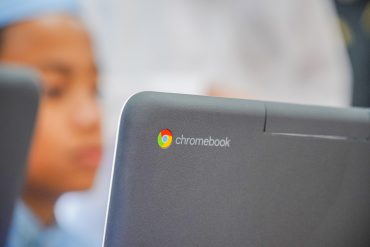
Global Chromebook Market Reaches $14.7 Billion, Led by Lenovo
5 minute read

Chromebook shipments drive cloud computing growth as manufacturers expand premium device offerings across education and business sectors
Three Key Facts
- Chromebook market surges to $14.7 billion in 2025 with projected growth to $42.85 billion by 2034, representing a 12.62% compound annual growth rate that outpaces traditional PC market expansion.
- Lenovo leads Chromebook shipments with 24.2% market share in Q1 2025, followed by HP at 20.3% and Dell at 15.2%, as major PC manufacturers pivot resources toward the growing Chrome OS segment.
- Chrome OS holds just 1.83% of desktop market share despite robust hardware sales growth, highlighting the challenge of competing against Windows’ dominant 70.21% market position in enterprise environments.
Introduction
The Chromebook market demonstrates remarkable momentum as manufacturers pivot toward cloud-centric computing solutions that challenge traditional Windows laptop dominance. Recent market data reveals the global Chromebook sector has reached $14.7 billion in 2025, with shipments growing alongside broader notebook market expansion of approximately 10% year-over-year.
This growth trajectory reflects a fundamental shift in how consumers and businesses approach personal computing needs. Chromebooks now compete directly with Windows laptops in segments previously considered beyond their reach, including premium business applications and advanced productivity workflows.
Key Developments
Major PC manufacturers have significantly expanded their Chromebook portfolios throughout 2025. Lenovo captured the largest market share at 24.2%, while HP secured 20.3% and Dell maintained 15.2% of global Chromebook shipments in the first quarter.
The hardware evolution proves particularly noteworthy. Premium Chromebook models now feature enhanced displays, robust build quality, and performance specifications that rival traditional laptops. ZDNet testing confirms that devices like the Lenovo Flex 5i Chromebook Plus deliver performance comparable to Windows laptops costing twice their $600 price point.
Google’s ecosystem integration has deepened with automatic device synchronization, seamless account transitions, and enhanced Android app compatibility. These developments address previous limitations that restricted Chromebook adoption in professional environments.
Market Impact
Combined desktop and notebook shipments reached 62.7 million units in Q1 2025, representing a 9.4% year-over-year increase. Chromebook shipments contributed meaningfully to this growth, with manufacturers reporting strong demand across education and business segments.
The global installed base approaches 300 million large-screen Chrome OS devices, establishing a substantial user foundation that supports continued software development and enterprise adoption. This scale provides manufacturers with predictable revenue streams and justifies continued investment in Chrome OS hardware innovation.
However, market share data reveals persistent challenges. Chrome OS maintains only 1.83% of the desktop operating system market compared to Windows’ commanding 70.21% share, indicating that growth remains concentrated in specific use cases rather than broad market displacement.
Strategic Insights
The Chromebook surge represents a classic disruption pattern where lower-cost alternatives gradually capture market segments through improved functionality and value propositions. Educational institutions continue driving adoption due to cost advantages and simplified device management requirements.
Enterprise adoption accelerates as businesses recognize total cost of ownership benefits including automatic updates, enhanced security, and reduced IT maintenance overhead. Cloud-first organizations particularly benefit from Chromebook deployment strategies that align with their infrastructure investments.
Traditional PC manufacturers face strategic pressure to balance Windows and Chrome OS portfolios. Companies like Lenovo, HP, and Dell must navigate relationships with both Microsoft and Google while optimizing manufacturing and distribution resources across competing platforms.
Expert Opinions and Data
Industry analysts project the Chromebook market will reach $42.85 billion by 2034, driven by continued hardware improvements and expanding use case applications. This growth rate significantly exceeds traditional PC market projections, reflecting fundamental shifts in computing preferences.
Technology reviewers increasingly recommend Chromebooks for specific user profiles. Testing data shows devices like the Lenovo Flex 5i manage demanding workloads including 50 open browser tabs and multiple video streams while maintaining nine-hour battery life under standard usage conditions.
Market researchers note that Chrome OS success depends heavily on cloud connectivity and web-based application adoption. Organizations with legacy software requirements continue favoring Windows systems, creating natural market segmentation between cloud-native and traditional computing environments.
Conclusion
The Chromebook market has evolved from a niche educational tool into a significant computing platform that challenges traditional laptop categories through cost leadership and cloud integration advantages. Manufacturers report strong shipment growth and expanding market opportunities across consumer and business segments.
Despite impressive growth trajectories and improved hardware capabilities, Chrome OS faces substantial challenges in displacing Windows’ enterprise dominance. The current market dynamics suggest continued coexistence rather than wholesale platform replacement, with Chromebooks securing specific segments while Windows maintains broader market leadership.





